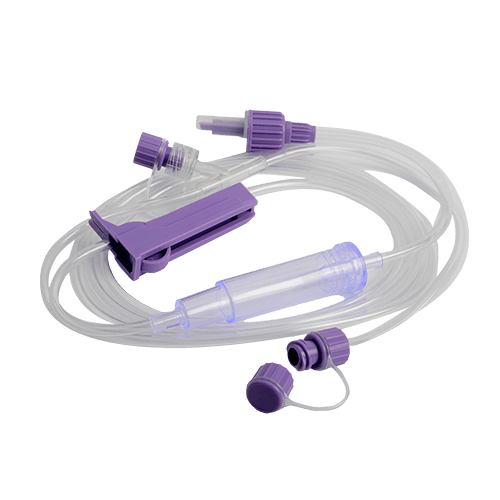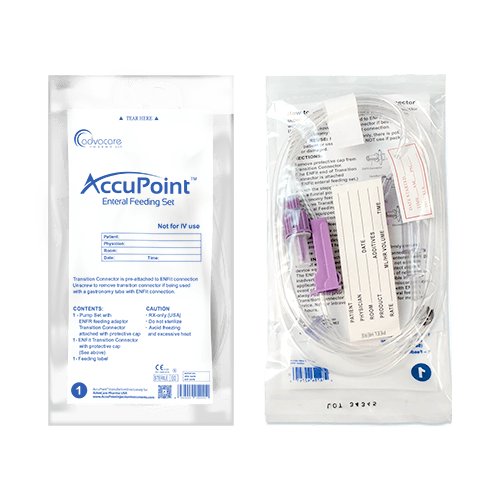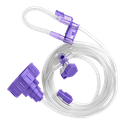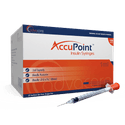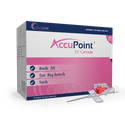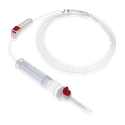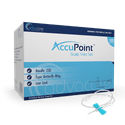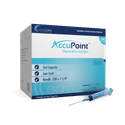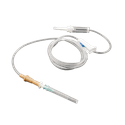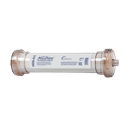- Home›
- Medical Devices›
- Injection Instruments›
- Enteral Feeding Sets›
- Enteral Feeding Set
Enteral Feeding Set
Type
Connector
Set Components
Packaging
What is an Enteral Feeding Set?
An Enteral Feeding Set is a medical device used to bring nutrition directly to the stomach or small intestine through a tube inserted into the nose, mouth, or stomach. The kit contains an adapter with cap, inlet port, plastic dropper, tube, roller clamp, and connector. It has two types: pump and gravity.
Enteral feeding kits are recommended for individuals who are unable to take food orally due to various medical conditions. This includes patients with swallowing difficulties, neurological disorders, cancer, or severe gastrointestinal diseases. Proper usage and maintenance of the enteral feeding set are crucial to prevent infections and other complications.
AdvaCare Pharma is a global supplier and manufacturer of high-quality Enteral Feeding Sets. Our medical devices are manufactured in facilities in China, India, and the USA, all of which are regularly evaluated to ensure that they comply with all health, safety, and environmental standards.
Product Specifications
Type
Connector
Set Components
Pump
Pump feeding in an enteral feeding set is a method of administering feed through a feeding pump and a giving set attached to the end of an enteral feeding tube. This method allows for precise delivery of a set amount of feed over a specific time period. It is commonly used in enteral feeding therapy to ensure accurate and controlled nutrition delivery to patients. (Pump is not included in this enteral feeding set).
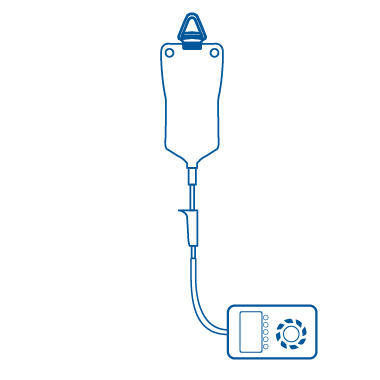
Gravity
Gravity enteral feeding sets do not require a pump. The set consists of a tube and a roller clamp which is released to allow the feed to flow down the tube by gravity. The feed is placed in the inlet port, and the roller clamp is adjusted to control the flow of the feed.
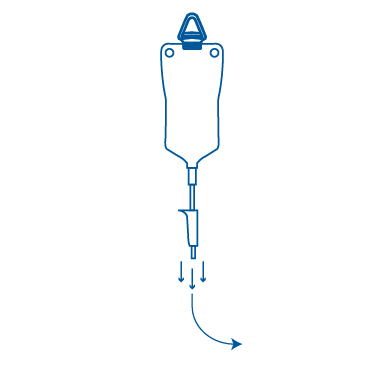
Needle Connector
Needle Connector in an enteral feeding kit is a small plastic component that connects the enteral feeding tube to the syringe or feeding pump. It allows for a secure and leak-proof connection, ensuring the safe and efficient delivery of nutrition. The needle connector is often color-coded to indicate its size and compatibility with different feeding tubes.
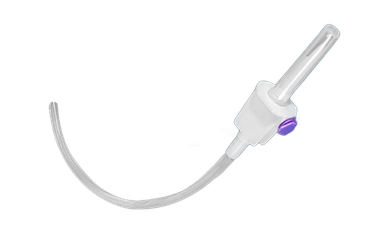
Universal Bottle Adapter
Universal Bottle Adapter is a component of an enteral feeding set that allows for the attachment of the feeding tube to a wide range of standard bottle sizes. It is designed to fit securely onto the bottle, ensuring that there is no leakage during feeding. The adapter can be reused for multiple feedings.
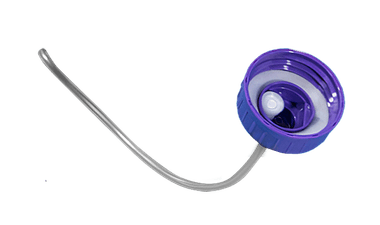
Adapter with Cap
Adapter with Cap connects the enteral feeding tube to the feeding bag or container. The cap on the adapter helps to protect the feeding tube from contamination and aids maintaining the sterility of the feeding system. It is designed to create a secure and leak-free connection, ensuring that the patient receives the correct amount of nutrition.
Inlet Port
Inlet Port is a device that connects the feeding tube to the feeding bag or bottle. It typically features a protective cap that helps to maintain sterility prior to use. The port is designed to be compatible with a variety of feeding sets, making it a versatile component in enteral feeding systems.
Plastic Dropper
Plastic Dropper helps control the flow rate of the feeding solution passing through the tube. The dropper is attached to the end of the tube and is used to regulate the amount of formula being delivered to the patient. It is typically made of a durable and medical-grade plastic material.
Tube
Tube is a vital part of the enteral feeding set and functions by connecting the feeding bag or bottle to the patient's nose, mouth, or stomach. It is usually made of soft, medical-grade plastic, and comes in different lengths and diameters to suit different various feeding requirements. The tube is designed to be non-irritating and easy to insert, while still providing a secure and leak-free connection.
Roller Clamp
Roller Clamp is a mechanism used to control the flow of the enteral feeding solution through the feeding tube. It works by compressing the tube to restrict or allow the flow of the solution. The clamp can be adjusted by rolling it up or down the tube to increase or decrease the flow rate.
Connector
Connector is a piece that attaches to the end of the feeding tube and connects it to the feeding bag or container. It plays a crucial role in the proper administration of the enteral feed. The connector is designed to ensure a secure and leak-free connection, preventing any accidental disconnection during feeding.
Why are we a quality Enteral Feeding Set manufacturer?
AdvaCare Pharma is a leading manufacturer of high-quality Enteral Feeding Sets. Our AccuPoint™ brand medical devices are manufactured in ISO and CE-certified facilities to ensure that our partners receive only the best-quality products. We supply medical distributors, hospitals, pharmacies, NGOs, and government institutions in over 65 markets worldwide, and we conduct frequent internal and third-party facility inspections to ensure that our products meet and exceed the standards required by our partners.
Our data-driven and methodical approach to supply chain management is supported by a team of highly skilled professionals, and all AccuPoint™ medical devices are accompanied by a STED dossier. In addition, we can provide CE, ISO and FDA certifications for some product specifications. At AdvaCare Pharma, we are committed to providing safe, effective, and reliable medical devices that help our partners lead in their respective industries.
Uses
How should an Enteral Feeding Set be used?
To use an enteral feeding set, hands should first be washed thoroughly with soap and water. Ensure that the feeding solution is at the correct temperature and has been properly mixed. Next, open the packaging of the set and attach the feeding bag or bottle to the inlet port of the set. Hang the feeding bag or bottle on a sturdy hook or pole.
Insert the feeding tube through the patient's nose or mouth, down into the stomach or intestine, and secure it in place. Open the roller clamp to allow the feeding solution to flow at the prescribed rate.
How should an Enteral Feeding Set be disposed of?
When the feeding is complete, close the roller clamp and properly dispose of the set according to local regulations, typically by placing it in a biohazard waste container.
It is important to follow proper disposal procedures to prevent the spread of infection or contamination.
FAQs
What are the parts of an Enteral Feeding Set?
An enteral feeding set consists of an adapter with cap, inlet port, plastic dropper, tube, roller clamp, and connector. Some sets may also include a pump, which allows for controlled and continuous feeding.
What is the difference between a pump and gravity Enteral Feeding Set?
A pump feeding set uses an electronic device to regulate the flow rate of the feeding, while gravity feeding sets rely on gravity to allow the feeding to flow through the tubing. Pump sets offer more precise control over the feeding rate, while gravity sets can be more convenient and portable.
How should Enteral Feeding Sets be stored?
Enteral feeding kits should be stored in a cool, dry place to avoid damage to the tubing or connectors. It is important to avoid exposing the sets to direct sunlight or extreme temperatures, which can cause the tubing to become brittle or crack.
What is the maximum duration an Enteral Feeding Set can be used for?
Feeding kits have a maximum recommended duration of use, which can vary depending on the product instructions and the specific type of set. Typically, they should be replaced every 24 to 48 hours, or sooner if there are signs of damage or contamination.
How should an enteral feeding kit be disposed of?
Feeding kits should be disposed of in accordance with local regulations for medical waste. The bag, tubing, and any other disposable components should be thrown in a medical waste container, while any reusable components should be thoroughly cleaned and disinfected before reuse or disposal.

You might be interested in...
Why AdvaCare Pharma?
As an industry leader, we are aware of our responsibility to provide affordable and sustainable solutions to improve healthcare worldwide.
